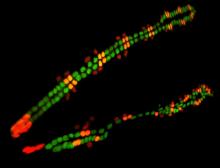You are here
Ahmad, Shaad

Shaad M. Ahmad
Assistant Professor
Ph.D., Stanford University School of Medicine
Phone: 812-237-2390
E-mail: Shaad.Ahmad@indstate.edu
Office: Science Building 287H
Ahmad Lab Website: https://www.indstate.edu/cas/AhmadLab
Research Interests: Cardiogenesis (heart development); Organogenesis; Transcriptional regulatory networks; Systems biology; Developmental biology; Computational biology; Genetics; Functional genomics
A comparison of the molecular mechanisms governing heart development in vertebrates and Drosophila reveals a remarkable conservation of all major regulatory components, including both signals and transcription factors. Furthermore, many of these conserved cardiac regulators are found to be mutated in various types of human congenital heart disease. The identification of genes involved in cardiac development in Drosophila and detailed investigations of their functions thus provide considerable insight into related mechanisms controlling cardiogenesis in vertebrates, including humans.
My laboratory utilizes integrated genetic, genomic, and computational strategies to identify novel genes involved in Drosophila heart development, investigate both their function and regulation, and examine the role of their orthologs in vertebrate and mammalian cardiogenesis. Our ultimate goal is to arrive at a comprehensive understanding of heart development which incorporates both a systems-level view of the underlying genetic network and detailed examinations of the roles of individual genes.
We also use similar integrated approaches to examine and dissect biological processes involved in the development of other organs besides the heart. Current research projects in the laboratory include:
Functional analysis of cardiogenic processes regulated by Forkhead (Fkh/Fox) transcription factors.
At least 4 transcription factors (TFs) of the Forkhead (Fkh/Fox) family are required for proper cardiac development in mammals, while mutations in 3 Fkh genes have been linked to human congenital heart defects. However, relatively little is known about the molecular mechanisms or the downstream targets by which these Fkh-mediated developmental functions are brought about. Our prior work in Drosophila identified the roles of two Fkh genes, jumu and CHES-1-like, in specifying cardiac cell subtypes and number by mediating cardiac progenitor cell divisions, and in determining cardiac fates. We also showed that Fkh TF binding sites were significantly enriched in the enhancers of cardiac genes. Collectively, these results indicate that these two Fkh TFs integrate multiple cardiogenic processes by regulating a large number of downstream target genes, raising the question of what these target genes are and what their individual functions might be during heart development.

Utilizing genome-wide transcription expression profiles of mesodermal cells from wild-type embryos and embryos with appropriate genetic perturbations in the Fkh genes, we have identified 963 jumu-regulated and 427 CHES-1-like-regulated target genes. We are now identifying and functionally analyzing the diverse cardiogenic cellular processes mediated by these Fkh targets.
Determining the functional roles of regulatory genes implicated in cardiogenesis.
By combining expression profiling, statistical meta-analysis and large scale in situ hybridizations, we had identified novel Drosophila  regulatory genes expressed in the heart or its precursor, the cardiac mesoderm. In a separate project, using machine learning to classify cardiac enhancers based primarily on the transcription factor binding sites of orthologous vertebrate TFs, we identified additional Drosophila TFs regulating cardiac genes. An ongoing screen based on knockdown RNA interference assays and loss-of-function mutant analysis has already determined that 48 of these genes exhibit robust cardiac phenotypes when their functions are disrupted. We are now examining the functional roles of these 48 regulatory genes in heart development in greater detail.
regulatory genes expressed in the heart or its precursor, the cardiac mesoderm. In a separate project, using machine learning to classify cardiac enhancers based primarily on the transcription factor binding sites of orthologous vertebrate TFs, we identified additional Drosophila TFs regulating cardiac genes. An ongoing screen based on knockdown RNA interference assays and loss-of-function mutant analysis has already determined that 48 of these genes exhibit robust cardiac phenotypes when their functions are disrupted. We are now examining the functional roles of these 48 regulatory genes in heart development in greater detail.
Examination of mesenchyme-to-epithelial transitions (METs).
The transition from loosely associated, polarity-lacking mesenchymal cells to planar arrays of tightly-packed epithelial cells characterized by apical-basal polarity plays a critical role not only in mammalian cardiogenesis, but also in hepatogenesis (liver development) and nephrogenesis (kidney development). We are studying MET using a Drosophila imaginal disc model which exhibits a remarkable conservation of signals with mammalian kidney development.
SELECTED PUBLICATIONS
Panta, M., Kump, A. J., Schwab, K. R., and Ahmad, S. M. (2022). Assessing the Roles of Potential Notch Signaling Components in Instructive and Permissive Pathways with Two Drosophila Pericardial Reporters. Methods in Molecular Biology 2472, 109-130. ![]() Download (750 KB)
Download (750 KB)
Kump, A. J., Panta, M., Schwab, K. R., Inlow, M. H., and Ahmad, S. M. (2021). The Drosophila Forkhead/Fox transcription factor Jumeau mediates specific cardiac progenitor cell divisions by regulating expression of the kinesin Nebbish. Scientific Reports 11, 3221.![]() Download - (3.30 MB)
Download - (3.30 MB)
Panta, M., Kump, A. J., Dalloul, J. M., Schwab, K. R., and Ahmad, S. M. (2020). Three distinct mechanisms, Notch instructive, permissive, and independent, regulate the expression of two different pericardial genes to specify cardiac cell subtypes. PLoS ONE 15, e0241191. ![]() Download - (3.32 MB)
Download - (3.32 MB)
Ahmad, S. M. (2017). Conserved signaling mechanisms in Drosophila heart development. Developmental Dynamics 246, 641-656. ![]() Download - (748 KB)
Download - (748 KB)
Ahmad, S. M., Bhattacharyya, P., Jeffries, N., Gisselbrecht, S. S. and Michelson, A. M. (2016). Two Forkhead transcription factors regulate cardiac progenitor specification by controlling the expression of receptors of the fibroblast growth factor and Wnt signaling pathways. Development 143, 306-317. ![]() Download - (2.96 MB)
Download - (2.96 MB)
Ahmad, S. M., Busser, B. W., Huang, D., Cozart, E. J., Michaud, S., Zhu, X., Jeffries, N., Aboukhalil, A., Bulyk, M.L., Ovcharenko, I. and Michelson, A. M. (2014). Machine learning classification of cell-specific cardiac enhancers uncovers developmental subnetworks regulating progenitor cell division and cell fate specification. Development 141, 878-888. ![]() Download- (5.55 MB)
Download- (5.55 MB)
Ahmad, S. M., Tansey, T. R., Busser, B. W., Nolte, M. T., Jeffries, N., Gisselbrecht, S. S., Rusan, N. M. and Michelson, A. M. (2012). Two Forkhead transcription factors regulate the division of cardiac progenitor cells by a Polo-dependent pathway. Developmental Cell 23, 97-111. ![]() Download- (1.13 MB)
Download- (1.13 MB)
Zhu, X., Ahmad, S. M., Aboukhalil, A., Busser, B. W., Kim, Y., Tansey, T. R., Haimovich, A., Jeffries, N., Bulyk, M. L. and Michelson, A. M. (2012). Differential regulation of mesodermal gene expression by Drosophila cell type-specific Forkhead transcription factors. Development 139, 1457-1466. ![]() Download- (1.07 MB)
Download- (1.07 MB)
Ahmad, S. M. and Baker, B. S. (2002). Sex-specific deployment of FGF signaling in Drosophila recruits mesodermal cells into the male genital imaginal disc. Cell 109, 651-661. ![]() Download - (448 KB)
Download - (448 KB)
Highlighted in Science “Perspective”: Burtis, K. C. (2002). Doublesex in the middle. Science 297, 1135-1136. ![]() Download- (260 KB)
Download- (260 KB)
Christiansen, A. E., Keisman, E. L., Ahmad, S. M. and Baker, B. S. (2002). Sex comes in from the cold. Trends in Genetics 18, 510-516. ![]() Download - (189 KB)
Download - (189 KB)
